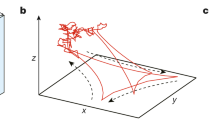Abstract
Sinking aggregates provide important nutrient-rich environments for marine bacteria. Quantifying the rate at which motile bacteria colonize such aggregations is important in understanding the microbial loop in the pelagic food web. In this paper, a simple analytical model is presented to predict the rate at which bacteria undergoing a random walk encounter a sinking aggregate. The model incorporates the flow field generated by the sinking aggregate, the swimming behavior of the bacteria, and the interaction of the flow with the swimming behavior. An expression for the encounter rate is computed in the limit of large Péclet number when the random walk can be approximated by a diffusion process. Comparison with an individual-based numerical simulation is also given.
Similar content being viewed by others
References
Acrivos, A., Goddard, J.D., 1965. Asymptotic expansions for laminar forced-convection heat and mass transfer. Part 1. Low speed flows. J. Fluid Mech. 23, 273–291.
Alldredge, A.L., Gotschalk, C., 1988. In situ settling behavior of marine snow. Limnol. Oceanogr. 33, 339–351.
Azam, F., 1998. Microbial control of oceanic carbon flux: The plot thickens. Science 280, 694–696.
Barbara, G.M., Mitchell, J.G., 2003. Bacterial tracking of motile algae. FEMS Microbiol. Ecol. 44, 79–87.
Batchelor, G.K., 1967. An introduction to fluid dynamics. Cambridge University Press, New York.
Bearon, R.N., 2003. An extension of generalized Taylor dispersion in unbounded homogeneous shear flows to run-and-tumble chemotactic bacteria. Phys. Fluids 15, 1552–1563.
Berg, H.C., 1983. Random Walks in Biology. Princeton University Press, Englewood Cliffs, NJ.
Berg, H.C., Brown, D.A., 1972. Chemotaxis in Escherichia coli analysed by three-dimensional tracking. Nature 239, 500–504.
Blackburn, N., Fenchel, T., Mitchell, J., 1998. Microscale nutrient patches in planktonic habitats shown by chemotactic bacteria. Science 282, 2254–2256.
Bowen, J.D., Stolzenbach, K.D., Chisholm, S.W., 1993. Simulating bacterial clustering around phytoplankton cells in a turbulent ocean. Limnol. Oceanogr. 38, 36–51.
Caron, D.A., Davis, P.G., Madin, L.P., Sieburth, J.M., 1986. Enrichment of microbial populations in macroaggrgates (marine snow) from surface waters of the North Atlantic. J. Mar. Res. 44, 543–565.
Clift, R., Grace, J.R., Weber, M.E., 1978. Bubbles, drops and particles. Academic, New York.
Frankel, I., Brenner, H., 1991. Generalized Taylor dispersion phenomena in unbounded homogeneous shear flows. J. Fluid Mech. 230, 147–181.
Gerritsen, J., Strickler, J.R., 1977. Encounter probabilities and community structure in zooplankton: A mathematical model. J. Fish. Res. Board Can. 34, 73–82.
Grimmett, G.R., Stirzaker, D.R. 1992. Probability and Random Processes, 2nd edition. Oxford University Press, Oxford.
Grossart, H.-P., Riemann, L., Azam, F. 2001. Bacterial motility in the sea and its ecological implications. Aquat. Microb. Ecol. 25, 247–258.
Hill, N.A., Bees, M.A., 2002. Taylor dispersion of gyrotactic swimming micro-organisms in a linear flow. Phys. Fluids 14, 2598–2605.
Hill, N.A., Häder, D.P., 1997. A biased random walk model for the trajectories of swimming micro-organisms. J. Theor. Biol. 186, 503–526.
Jackson, G.A., 1989. Simulation of bacterial attraction and adhesion to falling particles in an aquatic environment. Limnol. Oceanogr. 34, 514–530.
Johansen, J.E., Pinhassi, J., Blackburn, N., Zweifel, U.L., Hagström, A., 2002. Variability in motility characteristics among marine bacteria. Aquat. Microb. Ecol. 28, 229–237.
Karp-Boss, L., Boss, E., Jumars, P.A., 1996. Nutrient fluxes to planktonic osmotrophs in the presence of fluid motion. Oceanogr. Mar. Biol. Annu. Rev. 34, 71–107.
Kim, S., Karrila, S.J., 1991. Microhydrodynamics: Principles and Selected Applications. Butterworth-Heinemann, London.
Kiørboe, T., Grossart, H.-P., Ploug, H., Tang, K., 2002. Mechanisms and rates of bacterial colonization of sinking aggregates. Appl. Environ. Microbiol. 68, 3996–4006.
Kiørboe, T., Jackson, G.A., 2001. Marine snow, organic solute plumes, and optimal chemosensory behavior of bacteria. Limnol. Oceanogr. 46, 1309–1318.
Kiørboe, T., Ploug, H., Thygesen, U.H., 2001. Fluid motion and solute distribution around sinking aggregates. I. Small-scale fluxes and heterogeneity of nutrients in the pelagic environment. Mar. Ecol. Prog. Ser. 211, 1–13.
Leal, L.G., 1992. Laminar flow and convective transport processes: Scaling principles and asymptotic analysis. Butterworth-Heinemann, London.
Levich, V.G., 1962. Physiochemical hydrodynamics. Prentice-Hall, Englewood Cliffs, NJ.
Luchsinger, R.H., Bergersen, B., Mitchell, J.G., 1999. Bacterial swimming strategies and turbulence. Biophys. J. 77, 2377–2386.
Pedley, T.J., Kessler, J.O., 1990. A new continuum model for suspensions of gyrotactic micro-organisms. J. Fluid Mech. 212, 155–182.
Pedley, T.J., Kessler, J.O., 1992. Hydrodynamic phenomena in suspensions of swimming microorganisms. Annu. Rev. Fluid Mech. 24, 313–358.
Riffell, J.A., Krug, P.J., Zimmer, R.K., 2002. Fertilization in the sea. the chemical identity of an abalone sperm attractant. J. Exp. Biol. 205, 1439–1450.
Vladimirov, V.A., Wu, M.S.C., Pedley, T.J., Denissenko, P.V., Zakhidova, S.G., 2004. Measurement of cell velocity distributions in populations of motile algae. J. Exp. Biol. 207, 1203–1216.
Author information
Authors and Affiliations
Corresponding author
Rights and permissions
About this article
Cite this article
Bearon, R.N. A Model for Bacterial Colonization of Sinking Aggregates. Bull. Math. Biol. 69, 417–431 (2007). https://doi.org/10.1007/s11538-005-9038-8
Received:
Accepted:
Published:
Issue Date:
DOI: https://doi.org/10.1007/s11538-005-9038-8




